Leadership and Management: Units 10, 21, 24, 27, 32, 52, 54, 73
VerifiedAdded on 2020/06/05
|23
|5306
|149
Homework Assignment
AI Summary
This document provides a comprehensive solution to a leadership and management assignment, covering Units 10, 21, 24, 27, 32, 52, 54, and 73. Unit 10 focuses on developing effective presentations, including best practices, consultation, factors to consider, and communication media analysis. Unit 21 addresses administrative support for meetings, detailing meeting purposes, attendance, resource setup, and responsibilities. Unit 24 examines employee rights and responsibilities, including job roles, career pathways, information sources, organizational principles, public concerns, and representative bodies. Unit 27 covers information storage and retrieval, including systems, security, filing, and search techniques. Unit 32 explains producing meeting minutes, including different types, legal requirements, organizational conventions, and confidentiality. Unit 52 discusses using email effectively, including message transmission, safety, and archiving. Unit 54 explores resolving customer complaints, including complaint identification, negotiation, conflict management, organizational procedures, and escalation. Finally, Unit 73 delves into principles of leadership and management, covering decision-making, leadership styles, motivation, management responsibilities, and performance measurement. The assignment integrates management theories, practical applications, and real-world examples to provide a thorough understanding of the subject matter.
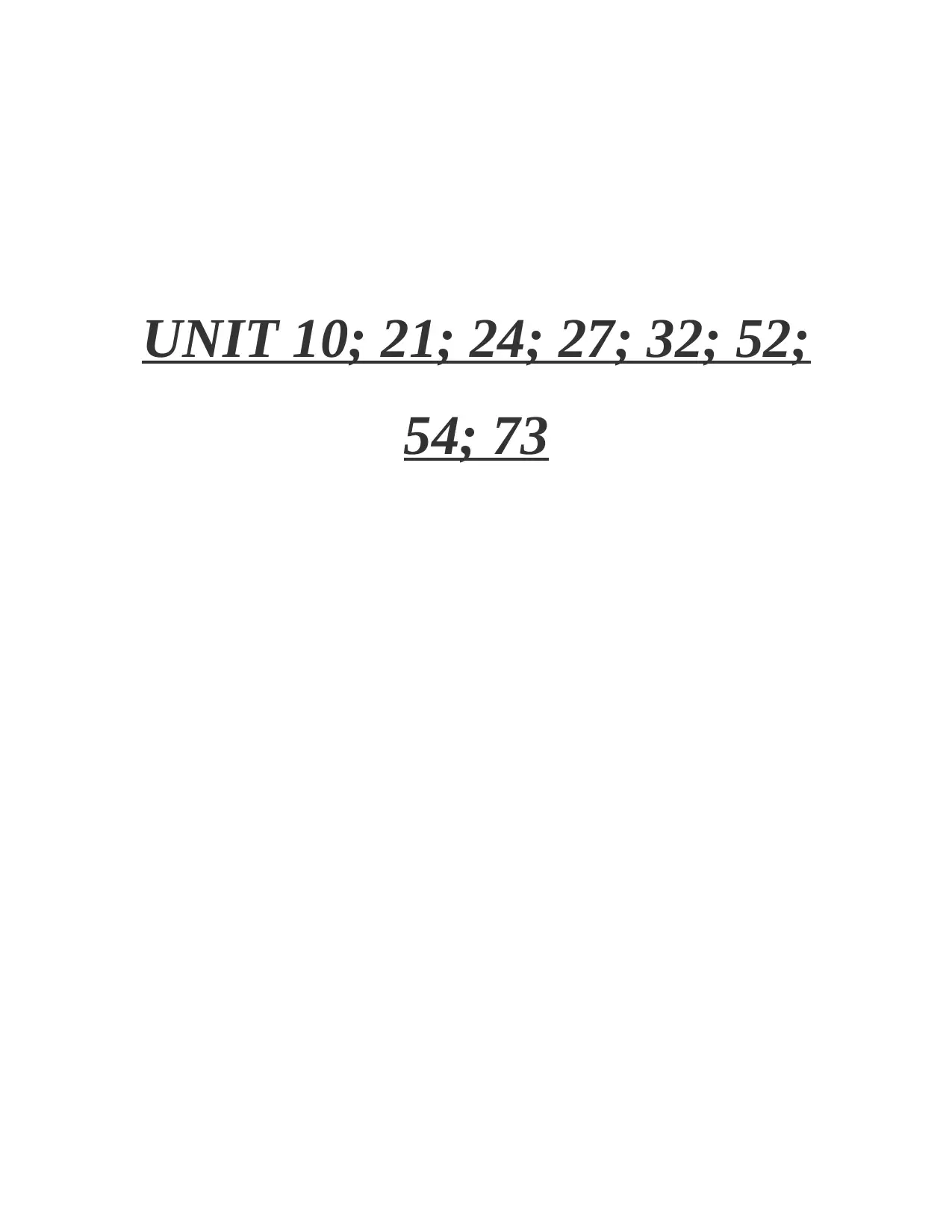
UNIT 10; 21; 24; 27; 32; 52;
54; 73
54; 73
Paraphrase This Document
Need a fresh take? Get an instant paraphrase of this document with our AI Paraphraser

Table of Contents
INTRODUCTION...........................................................................................................................1
UNIT 10 Develop a Presentation.....................................................................................................1
1.1 Explain best practice in developing presentations................................................................1
1.2 Explain who needs to be consulted on the development of a presentation...........................1
1.3 Explain the factors to be taken into account in developing a presentation...........................1
1.4 Analyse the advantages and limitations of different communication media........................2
2.1 Identify the purpose, content, style, timing and audience for a presentation........................2
UNIT 21 Provide Administrative Support for Meetings.................................................................2
1.1 Describe the purpose of the meeting and who needs to attend.............................................2
1.2 Explain why it is important to have a minimum number of attendees for a meeting...........2
1.3 Explain ways to achieve maximum attendance at meetings.................................................2
1.4 Explain the access, health, safety and security requirements relating to meetings...............2
1.5 Describe how to set up the resources needed for a meeting.................................................3
1.6 Explain the responsibilities of the meeting chair and meeting secretary..............................3
1.7 Explain the difference between formal and informal meetings ...........................................3
1.8 Explain the legal implications of formal meetings...............................................................4
UNIT 24 Employee Rights and Responsibilities.............................................................................4
TASK 1............................................................................................................................................4
1.1 Explain the role of their own occupation within an organisation and industry ...................4
1.2 Describe career pathways within their organisation and industry........................................4
1.3 Identify sources of information and advice on an industry, occupation, training and career
pathway ......................................................................................................................................4
1.4 Describe an organisation’s principles of conduct and codes of practice ..............................5
1.5 Explain issues of public concern that affect an organisation and industry...........................5
1.6 Describe the types, roles and responsibilities of representative bodies and their relevance
to their own role..........................................................................................................................5
TASK 2............................................................................................................................................6
2.1 Describe the employer and employee statutory rights and responsibilities that affect their
own role ......................................................................................................................................6
INTRODUCTION...........................................................................................................................1
UNIT 10 Develop a Presentation.....................................................................................................1
1.1 Explain best practice in developing presentations................................................................1
1.2 Explain who needs to be consulted on the development of a presentation...........................1
1.3 Explain the factors to be taken into account in developing a presentation...........................1
1.4 Analyse the advantages and limitations of different communication media........................2
2.1 Identify the purpose, content, style, timing and audience for a presentation........................2
UNIT 21 Provide Administrative Support for Meetings.................................................................2
1.1 Describe the purpose of the meeting and who needs to attend.............................................2
1.2 Explain why it is important to have a minimum number of attendees for a meeting...........2
1.3 Explain ways to achieve maximum attendance at meetings.................................................2
1.4 Explain the access, health, safety and security requirements relating to meetings...............2
1.5 Describe how to set up the resources needed for a meeting.................................................3
1.6 Explain the responsibilities of the meeting chair and meeting secretary..............................3
1.7 Explain the difference between formal and informal meetings ...........................................3
1.8 Explain the legal implications of formal meetings...............................................................4
UNIT 24 Employee Rights and Responsibilities.............................................................................4
TASK 1............................................................................................................................................4
1.1 Explain the role of their own occupation within an organisation and industry ...................4
1.2 Describe career pathways within their organisation and industry........................................4
1.3 Identify sources of information and advice on an industry, occupation, training and career
pathway ......................................................................................................................................4
1.4 Describe an organisation’s principles of conduct and codes of practice ..............................5
1.5 Explain issues of public concern that affect an organisation and industry...........................5
1.6 Describe the types, roles and responsibilities of representative bodies and their relevance
to their own role..........................................................................................................................5
TASK 2............................................................................................................................................6
2.1 Describe the employer and employee statutory rights and responsibilities that affect their
own role ......................................................................................................................................6
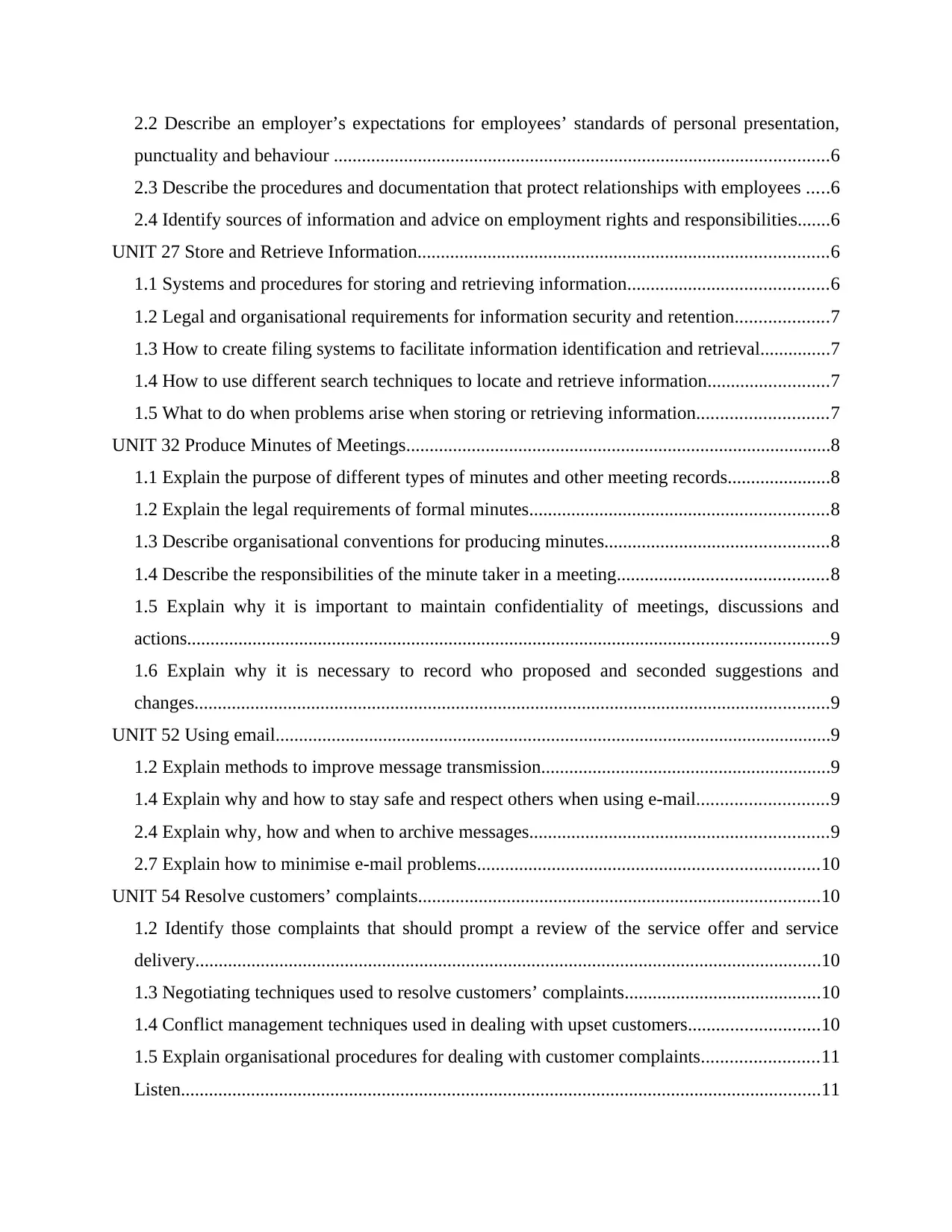
2.2 Describe an employer’s expectations for employees’ standards of personal presentation,
punctuality and behaviour ..........................................................................................................6
2.3 Describe the procedures and documentation that protect relationships with employees .....6
2.4 Identify sources of information and advice on employment rights and responsibilities.......6
UNIT 27 Store and Retrieve Information........................................................................................6
1.1 Systems and procedures for storing and retrieving information...........................................6
1.2 Legal and organisational requirements for information security and retention....................7
1.3 How to create filing systems to facilitate information identification and retrieval...............7
1.4 How to use different search techniques to locate and retrieve information..........................7
1.5 What to do when problems arise when storing or retrieving information............................7
UNIT 32 Produce Minutes of Meetings...........................................................................................8
1.1 Explain the purpose of different types of minutes and other meeting records......................8
1.2 Explain the legal requirements of formal minutes................................................................8
1.3 Describe organisational conventions for producing minutes................................................8
1.4 Describe the responsibilities of the minute taker in a meeting.............................................8
1.5 Explain why it is important to maintain confidentiality of meetings, discussions and
actions.........................................................................................................................................9
1.6 Explain why it is necessary to record who proposed and seconded suggestions and
changes........................................................................................................................................9
UNIT 52 Using email.......................................................................................................................9
1.2 Explain methods to improve message transmission..............................................................9
1.4 Explain why and how to stay safe and respect others when using e-mail............................9
2.4 Explain why, how and when to archive messages................................................................9
2.7 Explain how to minimise e-mail problems.........................................................................10
UNIT 54 Resolve customers’ complaints......................................................................................10
1.2 Identify those complaints that should prompt a review of the service offer and service
delivery......................................................................................................................................10
1.3 Negotiating techniques used to resolve customers’ complaints..........................................10
1.4 Conflict management techniques used in dealing with upset customers............................10
1.5 Explain organisational procedures for dealing with customer complaints.........................11
Listen.........................................................................................................................................11
punctuality and behaviour ..........................................................................................................6
2.3 Describe the procedures and documentation that protect relationships with employees .....6
2.4 Identify sources of information and advice on employment rights and responsibilities.......6
UNIT 27 Store and Retrieve Information........................................................................................6
1.1 Systems and procedures for storing and retrieving information...........................................6
1.2 Legal and organisational requirements for information security and retention....................7
1.3 How to create filing systems to facilitate information identification and retrieval...............7
1.4 How to use different search techniques to locate and retrieve information..........................7
1.5 What to do when problems arise when storing or retrieving information............................7
UNIT 32 Produce Minutes of Meetings...........................................................................................8
1.1 Explain the purpose of different types of minutes and other meeting records......................8
1.2 Explain the legal requirements of formal minutes................................................................8
1.3 Describe organisational conventions for producing minutes................................................8
1.4 Describe the responsibilities of the minute taker in a meeting.............................................8
1.5 Explain why it is important to maintain confidentiality of meetings, discussions and
actions.........................................................................................................................................9
1.6 Explain why it is necessary to record who proposed and seconded suggestions and
changes........................................................................................................................................9
UNIT 52 Using email.......................................................................................................................9
1.2 Explain methods to improve message transmission..............................................................9
1.4 Explain why and how to stay safe and respect others when using e-mail............................9
2.4 Explain why, how and when to archive messages................................................................9
2.7 Explain how to minimise e-mail problems.........................................................................10
UNIT 54 Resolve customers’ complaints......................................................................................10
1.2 Identify those complaints that should prompt a review of the service offer and service
delivery......................................................................................................................................10
1.3 Negotiating techniques used to resolve customers’ complaints..........................................10
1.4 Conflict management techniques used in dealing with upset customers............................10
1.5 Explain organisational procedures for dealing with customer complaints.........................11
Listen.........................................................................................................................................11
⊘ This is a preview!⊘
Do you want full access?
Subscribe today to unlock all pages.

Trusted by 1+ million students worldwide
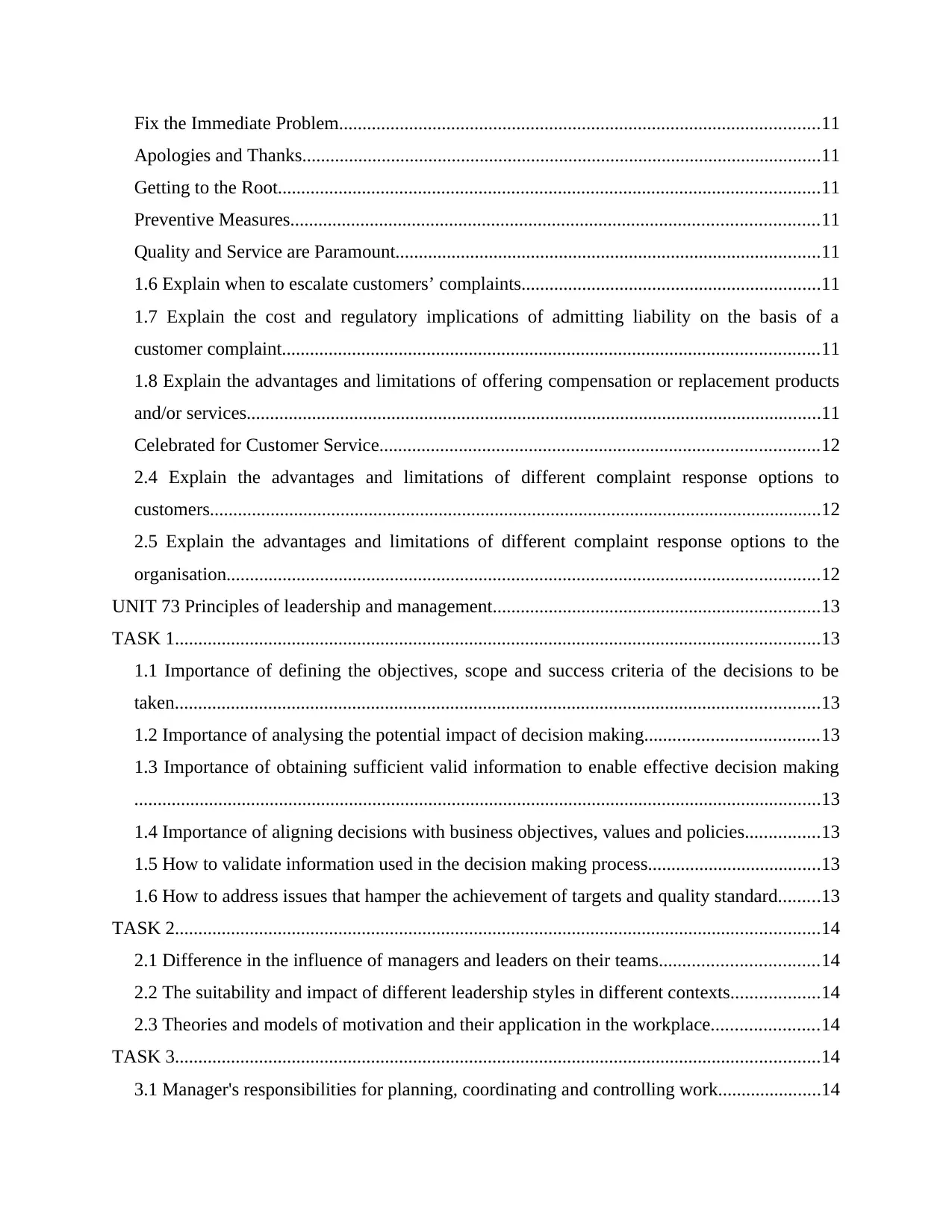
Fix the Immediate Problem.......................................................................................................11
Apologies and Thanks...............................................................................................................11
Getting to the Root....................................................................................................................11
Preventive Measures.................................................................................................................11
Quality and Service are Paramount...........................................................................................11
1.6 Explain when to escalate customers’ complaints................................................................11
1.7 Explain the cost and regulatory implications of admitting liability on the basis of a
customer complaint...................................................................................................................11
1.8 Explain the advantages and limitations of offering compensation or replacement products
and/or services...........................................................................................................................11
Celebrated for Customer Service..............................................................................................12
2.4 Explain the advantages and limitations of different complaint response options to
customers...................................................................................................................................12
2.5 Explain the advantages and limitations of different complaint response options to the
organisation...............................................................................................................................12
UNIT 73 Principles of leadership and management......................................................................13
TASK 1..........................................................................................................................................13
1.1 Importance of defining the objectives, scope and success criteria of the decisions to be
taken..........................................................................................................................................13
1.2 Importance of analysing the potential impact of decision making.....................................13
1.3 Importance of obtaining sufficient valid information to enable effective decision making
...................................................................................................................................................13
1.4 Importance of aligning decisions with business objectives, values and policies................13
1.5 How to validate information used in the decision making process.....................................13
1.6 How to address issues that hamper the achievement of targets and quality standard.........13
TASK 2..........................................................................................................................................14
2.1 Difference in the influence of managers and leaders on their teams..................................14
2.2 The suitability and impact of different leadership styles in different contexts...................14
2.3 Theories and models of motivation and their application in the workplace.......................14
TASK 3..........................................................................................................................................14
3.1 Manager's responsibilities for planning, coordinating and controlling work......................14
Apologies and Thanks...............................................................................................................11
Getting to the Root....................................................................................................................11
Preventive Measures.................................................................................................................11
Quality and Service are Paramount...........................................................................................11
1.6 Explain when to escalate customers’ complaints................................................................11
1.7 Explain the cost and regulatory implications of admitting liability on the basis of a
customer complaint...................................................................................................................11
1.8 Explain the advantages and limitations of offering compensation or replacement products
and/or services...........................................................................................................................11
Celebrated for Customer Service..............................................................................................12
2.4 Explain the advantages and limitations of different complaint response options to
customers...................................................................................................................................12
2.5 Explain the advantages and limitations of different complaint response options to the
organisation...............................................................................................................................12
UNIT 73 Principles of leadership and management......................................................................13
TASK 1..........................................................................................................................................13
1.1 Importance of defining the objectives, scope and success criteria of the decisions to be
taken..........................................................................................................................................13
1.2 Importance of analysing the potential impact of decision making.....................................13
1.3 Importance of obtaining sufficient valid information to enable effective decision making
...................................................................................................................................................13
1.4 Importance of aligning decisions with business objectives, values and policies................13
1.5 How to validate information used in the decision making process.....................................13
1.6 How to address issues that hamper the achievement of targets and quality standard.........13
TASK 2..........................................................................................................................................14
2.1 Difference in the influence of managers and leaders on their teams..................................14
2.2 The suitability and impact of different leadership styles in different contexts...................14
2.3 Theories and models of motivation and their application in the workplace.......................14
TASK 3..........................................................................................................................................14
3.1 Manager's responsibilities for planning, coordinating and controlling work......................14
Paraphrase This Document
Need a fresh take? Get an instant paraphrase of this document with our AI Paraphraser

3.2 How managers ensure that team objectives are met...........................................................14
3.3 How a manager's role contributes to the achievement of an organisation’s vision, mission
and objectives............................................................................................................................15
3.4 Theories and models of management..................................................................................15
3.5 How the application of management theories guide a manager's actions...........................15
3.6 The operational constraints imposed by budgets................................................................15
TASK 4..........................................................................................................................................15
4.1 Relationship between business objectives and performance measures...............................15
4.2 The features of a performance measurement system..........................................................15
4.3 How to set key performance indicators (KPIs)...................................................................15
4.4 Tools, processes and timetable for monitoring and reporting on business performance....16
4.5 Use of management accounts and management information systems in performance
management..............................................................................................................................16
4.6 Distinction between outcomes and outputs.........................................................................16
CONCLUSION..............................................................................................................................16
REFERENCES..............................................................................................................................17
3.3 How a manager's role contributes to the achievement of an organisation’s vision, mission
and objectives............................................................................................................................15
3.4 Theories and models of management..................................................................................15
3.5 How the application of management theories guide a manager's actions...........................15
3.6 The operational constraints imposed by budgets................................................................15
TASK 4..........................................................................................................................................15
4.1 Relationship between business objectives and performance measures...............................15
4.2 The features of a performance measurement system..........................................................15
4.3 How to set key performance indicators (KPIs)...................................................................15
4.4 Tools, processes and timetable for monitoring and reporting on business performance....16
4.5 Use of management accounts and management information systems in performance
management..............................................................................................................................16
4.6 Distinction between outcomes and outputs.........................................................................16
CONCLUSION..............................................................................................................................16
REFERENCES..............................................................................................................................17

INTRODUCTION
A program that generally prepares individuals to plan, organize, direct, and control the
functions and processes of a firm or organization (Bean, 2015). Includes instruction in
management theory, human resources management and behaviour, accounting and other
quantitative methods, purchasing and logistics, organization and production, marketing, and
business decision-making.
UNIT 10 Develop a Presentation
1.1 Explain best practice in developing presentations
Research
Skilful Composition
Cite experts or provide real life case studies.
Creating an environment of shared knowledge.
Keep bullet points and lists to a minimum.
Conclusion
1.2 Explain who needs to be consulted on the development of a presentation
Qualification structures
Progression opportunities
Choosing Units
Scoring points
Develop a Presentation
1.3 Explain the factors to be taken into account in developing a presentation
Clarity
Interest
Relevance to audience
Emphasis on Important Points
Short Sentence (Hettne, 2016).
Direct Speech and active mood
Appropriate Vocabulary
Link between Sections
1
A program that generally prepares individuals to plan, organize, direct, and control the
functions and processes of a firm or organization (Bean, 2015). Includes instruction in
management theory, human resources management and behaviour, accounting and other
quantitative methods, purchasing and logistics, organization and production, marketing, and
business decision-making.
UNIT 10 Develop a Presentation
1.1 Explain best practice in developing presentations
Research
Skilful Composition
Cite experts or provide real life case studies.
Creating an environment of shared knowledge.
Keep bullet points and lists to a minimum.
Conclusion
1.2 Explain who needs to be consulted on the development of a presentation
Qualification structures
Progression opportunities
Choosing Units
Scoring points
Develop a Presentation
1.3 Explain the factors to be taken into account in developing a presentation
Clarity
Interest
Relevance to audience
Emphasis on Important Points
Short Sentence (Hettne, 2016).
Direct Speech and active mood
Appropriate Vocabulary
Link between Sections
1
⊘ This is a preview!⊘
Do you want full access?
Subscribe today to unlock all pages.

Trusted by 1+ million students worldwide
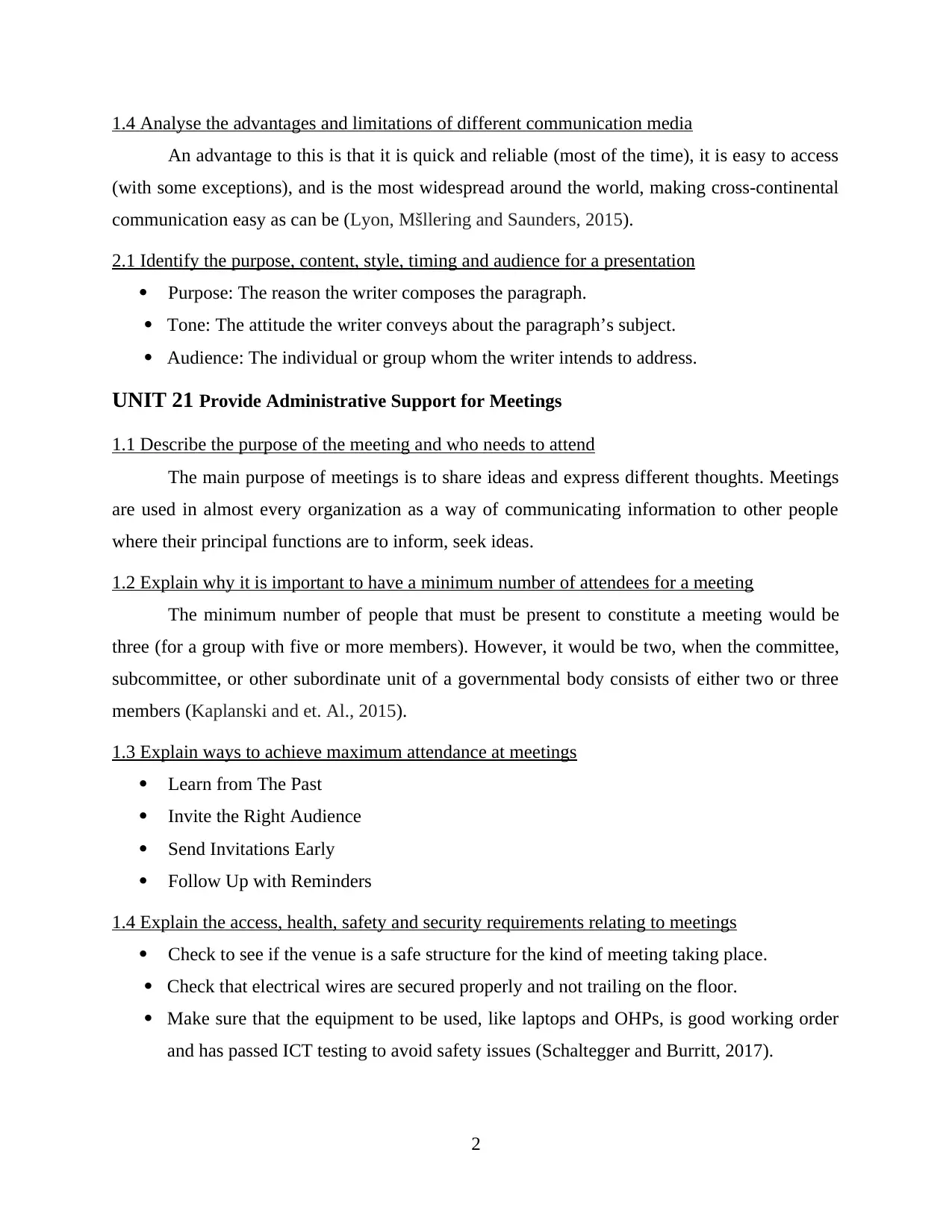
1.4 Analyse the advantages and limitations of different communication media
An advantage to this is that it is quick and reliable (most of the time), it is easy to access
(with some exceptions), and is the most widespread around the world, making cross-continental
communication easy as can be (Lyon, Mšllering and Saunders, 2015).
2.1 Identify the purpose, content, style, timing and audience for a presentation
Purpose: The reason the writer composes the paragraph.
Tone: The attitude the writer conveys about the paragraph’s subject.
Audience: The individual or group whom the writer intends to address.
UNIT 21 Provide Administrative Support for Meetings
1.1 Describe the purpose of the meeting and who needs to attend
The main purpose of meetings is to share ideas and express different thoughts. Meetings
are used in almost every organization as a way of communicating information to other people
where their principal functions are to inform, seek ideas.
1.2 Explain why it is important to have a minimum number of attendees for a meeting
The minimum number of people that must be present to constitute a meeting would be
three (for a group with five or more members). However, it would be two, when the committee,
subcommittee, or other subordinate unit of a governmental body consists of either two or three
members (Kaplanski and et. Al., 2015).
1.3 Explain ways to achieve maximum attendance at meetings
Learn from The Past
Invite the Right Audience
Send Invitations Early
Follow Up with Reminders
1.4 Explain the access, health, safety and security requirements relating to meetings
Check to see if the venue is a safe structure for the kind of meeting taking place.
Check that electrical wires are secured properly and not trailing on the floor.
Make sure that the equipment to be used, like laptops and OHPs, is good working order
and has passed ICT testing to avoid safety issues (Schaltegger and Burritt, 2017).
2
An advantage to this is that it is quick and reliable (most of the time), it is easy to access
(with some exceptions), and is the most widespread around the world, making cross-continental
communication easy as can be (Lyon, Mšllering and Saunders, 2015).
2.1 Identify the purpose, content, style, timing and audience for a presentation
Purpose: The reason the writer composes the paragraph.
Tone: The attitude the writer conveys about the paragraph’s subject.
Audience: The individual or group whom the writer intends to address.
UNIT 21 Provide Administrative Support for Meetings
1.1 Describe the purpose of the meeting and who needs to attend
The main purpose of meetings is to share ideas and express different thoughts. Meetings
are used in almost every organization as a way of communicating information to other people
where their principal functions are to inform, seek ideas.
1.2 Explain why it is important to have a minimum number of attendees for a meeting
The minimum number of people that must be present to constitute a meeting would be
three (for a group with five or more members). However, it would be two, when the committee,
subcommittee, or other subordinate unit of a governmental body consists of either two or three
members (Kaplanski and et. Al., 2015).
1.3 Explain ways to achieve maximum attendance at meetings
Learn from The Past
Invite the Right Audience
Send Invitations Early
Follow Up with Reminders
1.4 Explain the access, health, safety and security requirements relating to meetings
Check to see if the venue is a safe structure for the kind of meeting taking place.
Check that electrical wires are secured properly and not trailing on the floor.
Make sure that the equipment to be used, like laptops and OHPs, is good working order
and has passed ICT testing to avoid safety issues (Schaltegger and Burritt, 2017).
2
Paraphrase This Document
Need a fresh take? Get an instant paraphrase of this document with our AI Paraphraser

Make sure that any confidential documents taken to the meeting are not left behind and
are brought back safely. Also, make sure that only authorised people are allowed access
to those documents.
1.5 Describe how to set up the resources needed for a meeting
Before the Meeting
Date and time of the meeting The purpose of the meeting
During the Meeting
As people enter the room, check off their names on your attendee list or write down the
names as people enter the meeting room.
After the Meeting
After the meeting look through the notes and add any additional points that are left out,
clarifying any doubts then and there so you do not lose track of what was discussed in the
meeting
1.6 Explain the responsibilities of the meeting chair and meeting secretary
To provide leadership
To ensure the management committee functions properly
To ensure the organization is managed effectively
To provide support and supervision to the chief officer and senior team
To represent the organization as its figurehead
1.7 Explain the difference between formal and informal meetings
A formal meeting in a business environment is a pre-planned event with a formal notice
that most often is sent via email or an official company memo (Haselhuhn, Ormiston and Wong,
2015).
An informal meeting can take place almost anywhere, anytime, and there is seldom the
structure and formality that you will see in a formal meeting.
3
are brought back safely. Also, make sure that only authorised people are allowed access
to those documents.
1.5 Describe how to set up the resources needed for a meeting
Before the Meeting
Date and time of the meeting The purpose of the meeting
During the Meeting
As people enter the room, check off their names on your attendee list or write down the
names as people enter the meeting room.
After the Meeting
After the meeting look through the notes and add any additional points that are left out,
clarifying any doubts then and there so you do not lose track of what was discussed in the
meeting
1.6 Explain the responsibilities of the meeting chair and meeting secretary
To provide leadership
To ensure the management committee functions properly
To ensure the organization is managed effectively
To provide support and supervision to the chief officer and senior team
To represent the organization as its figurehead
1.7 Explain the difference between formal and informal meetings
A formal meeting in a business environment is a pre-planned event with a formal notice
that most often is sent via email or an official company memo (Haselhuhn, Ormiston and Wong,
2015).
An informal meeting can take place almost anywhere, anytime, and there is seldom the
structure and formality that you will see in a formal meeting.
3
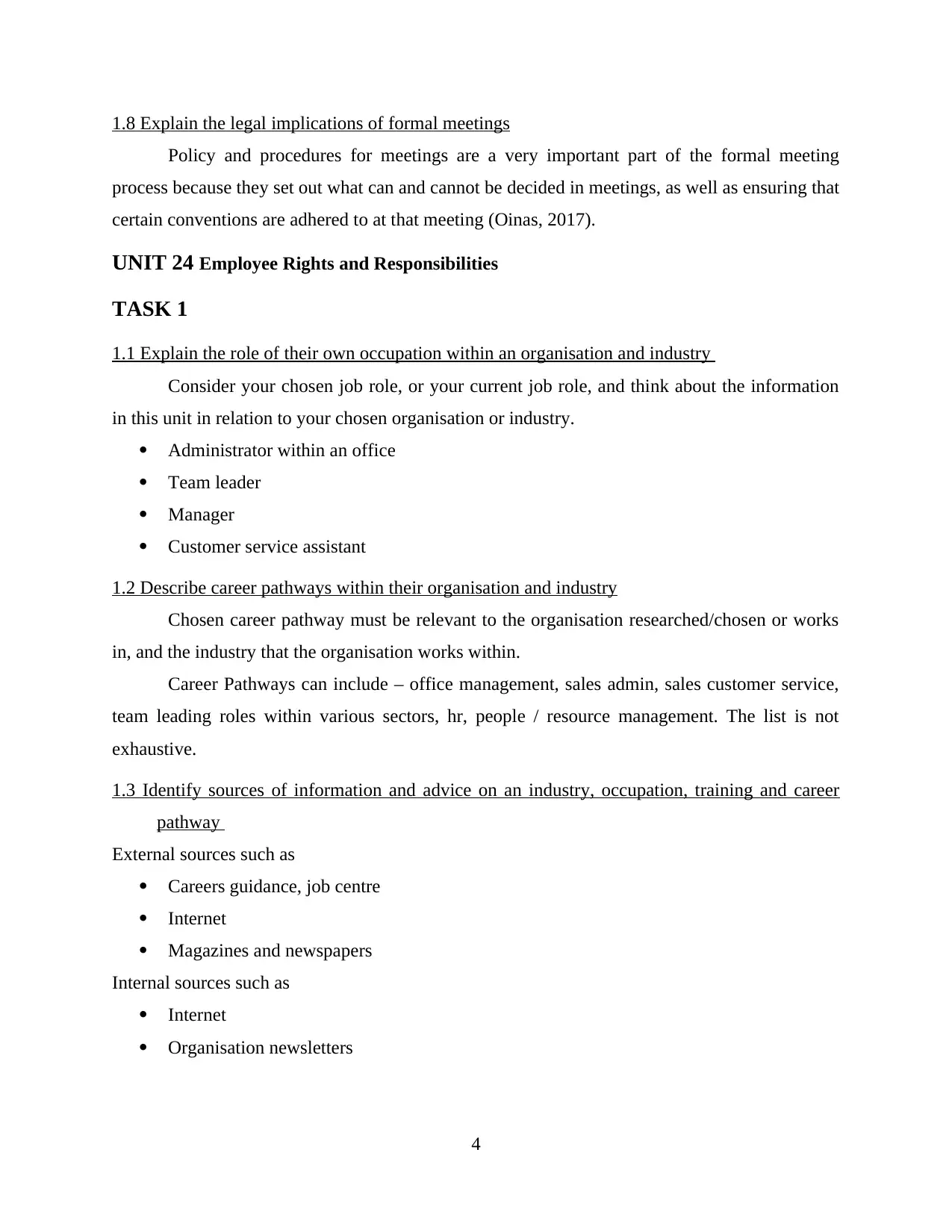
1.8 Explain the legal implications of formal meetings
Policy and procedures for meetings are a very important part of the formal meeting
process because they set out what can and cannot be decided in meetings, as well as ensuring that
certain conventions are adhered to at that meeting (Oinas, 2017).
UNIT 24 Employee Rights and Responsibilities
TASK 1
1.1 Explain the role of their own occupation within an organisation and industry
Consider your chosen job role, or your current job role, and think about the information
in this unit in relation to your chosen organisation or industry.
Administrator within an office
Team leader
Manager
Customer service assistant
1.2 Describe career pathways within their organisation and industry
Chosen career pathway must be relevant to the organisation researched/chosen or works
in, and the industry that the organisation works within.
Career Pathways can include – office management, sales admin, sales customer service,
team leading roles within various sectors, hr, people / resource management. The list is not
exhaustive.
1.3 Identify sources of information and advice on an industry, occupation, training and career
pathway
External sources such as
Careers guidance, job centre
Internet
Magazines and newspapers
Internal sources such as
Internet
Organisation newsletters
4
Policy and procedures for meetings are a very important part of the formal meeting
process because they set out what can and cannot be decided in meetings, as well as ensuring that
certain conventions are adhered to at that meeting (Oinas, 2017).
UNIT 24 Employee Rights and Responsibilities
TASK 1
1.1 Explain the role of their own occupation within an organisation and industry
Consider your chosen job role, or your current job role, and think about the information
in this unit in relation to your chosen organisation or industry.
Administrator within an office
Team leader
Manager
Customer service assistant
1.2 Describe career pathways within their organisation and industry
Chosen career pathway must be relevant to the organisation researched/chosen or works
in, and the industry that the organisation works within.
Career Pathways can include – office management, sales admin, sales customer service,
team leading roles within various sectors, hr, people / resource management. The list is not
exhaustive.
1.3 Identify sources of information and advice on an industry, occupation, training and career
pathway
External sources such as
Careers guidance, job centre
Internet
Magazines and newspapers
Internal sources such as
Internet
Organisation newsletters
4
⊘ This is a preview!⊘
Do you want full access?
Subscribe today to unlock all pages.

Trusted by 1+ million students worldwide
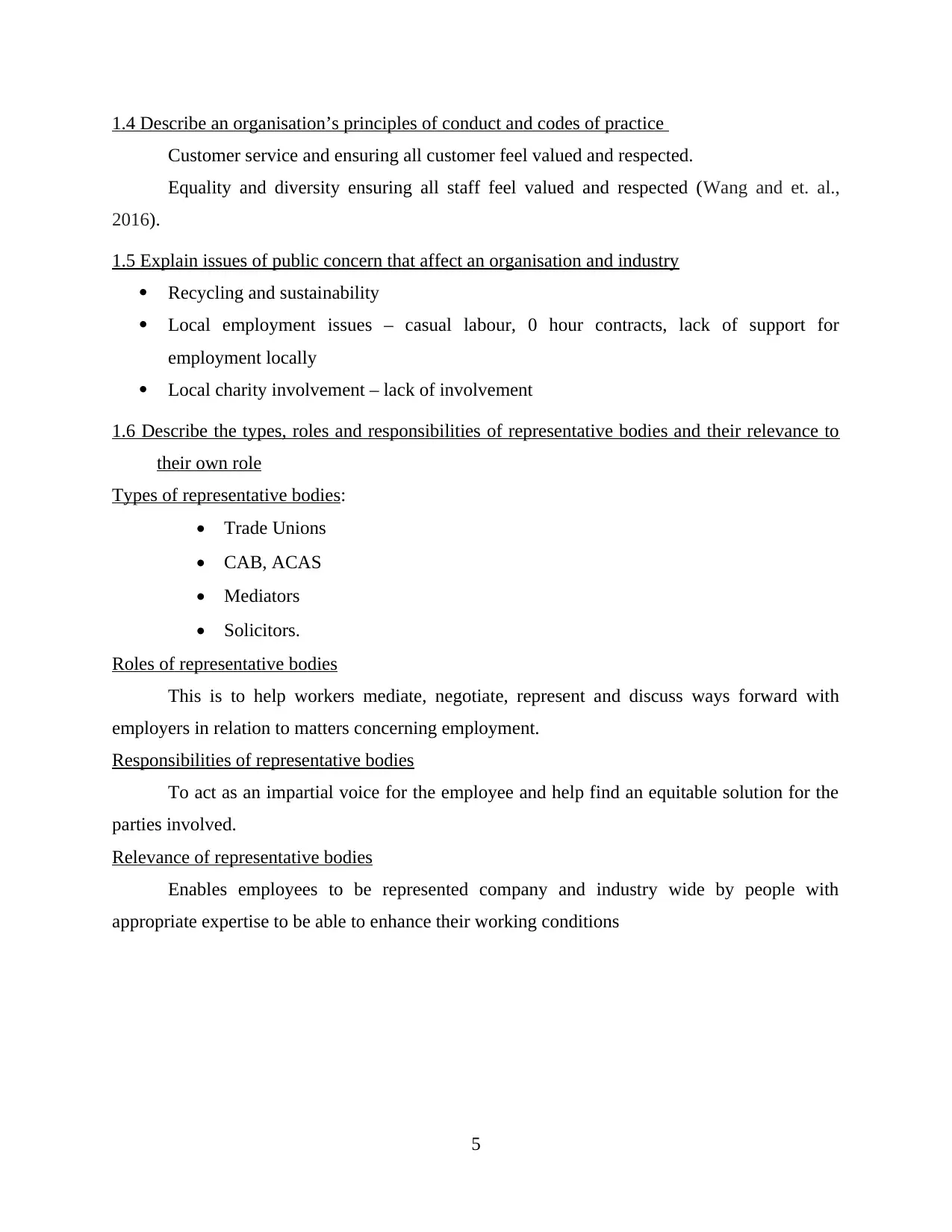
1.4 Describe an organisation’s principles of conduct and codes of practice
Customer service and ensuring all customer feel valued and respected.
Equality and diversity ensuring all staff feel valued and respected (Wang and et. al.,
2016).
1.5 Explain issues of public concern that affect an organisation and industry
Recycling and sustainability
Local employment issues – casual labour, 0 hour contracts, lack of support for
employment locally
Local charity involvement – lack of involvement
1.6 Describe the types, roles and responsibilities of representative bodies and their relevance to
their own role
Types of representative bodies:
• Trade Unions
• CAB, ACAS
• Mediators
• Solicitors.
Roles of representative bodies
This is to help workers mediate, negotiate, represent and discuss ways forward with
employers in relation to matters concerning employment.
Responsibilities of representative bodies
To act as an impartial voice for the employee and help find an equitable solution for the
parties involved.
Relevance of representative bodies
Enables employees to be represented company and industry wide by people with
appropriate expertise to be able to enhance their working conditions
5
Customer service and ensuring all customer feel valued and respected.
Equality and diversity ensuring all staff feel valued and respected (Wang and et. al.,
2016).
1.5 Explain issues of public concern that affect an organisation and industry
Recycling and sustainability
Local employment issues – casual labour, 0 hour contracts, lack of support for
employment locally
Local charity involvement – lack of involvement
1.6 Describe the types, roles and responsibilities of representative bodies and their relevance to
their own role
Types of representative bodies:
• Trade Unions
• CAB, ACAS
• Mediators
• Solicitors.
Roles of representative bodies
This is to help workers mediate, negotiate, represent and discuss ways forward with
employers in relation to matters concerning employment.
Responsibilities of representative bodies
To act as an impartial voice for the employee and help find an equitable solution for the
parties involved.
Relevance of representative bodies
Enables employees to be represented company and industry wide by people with
appropriate expertise to be able to enhance their working conditions
5
Paraphrase This Document
Need a fresh take? Get an instant paraphrase of this document with our AI Paraphraser
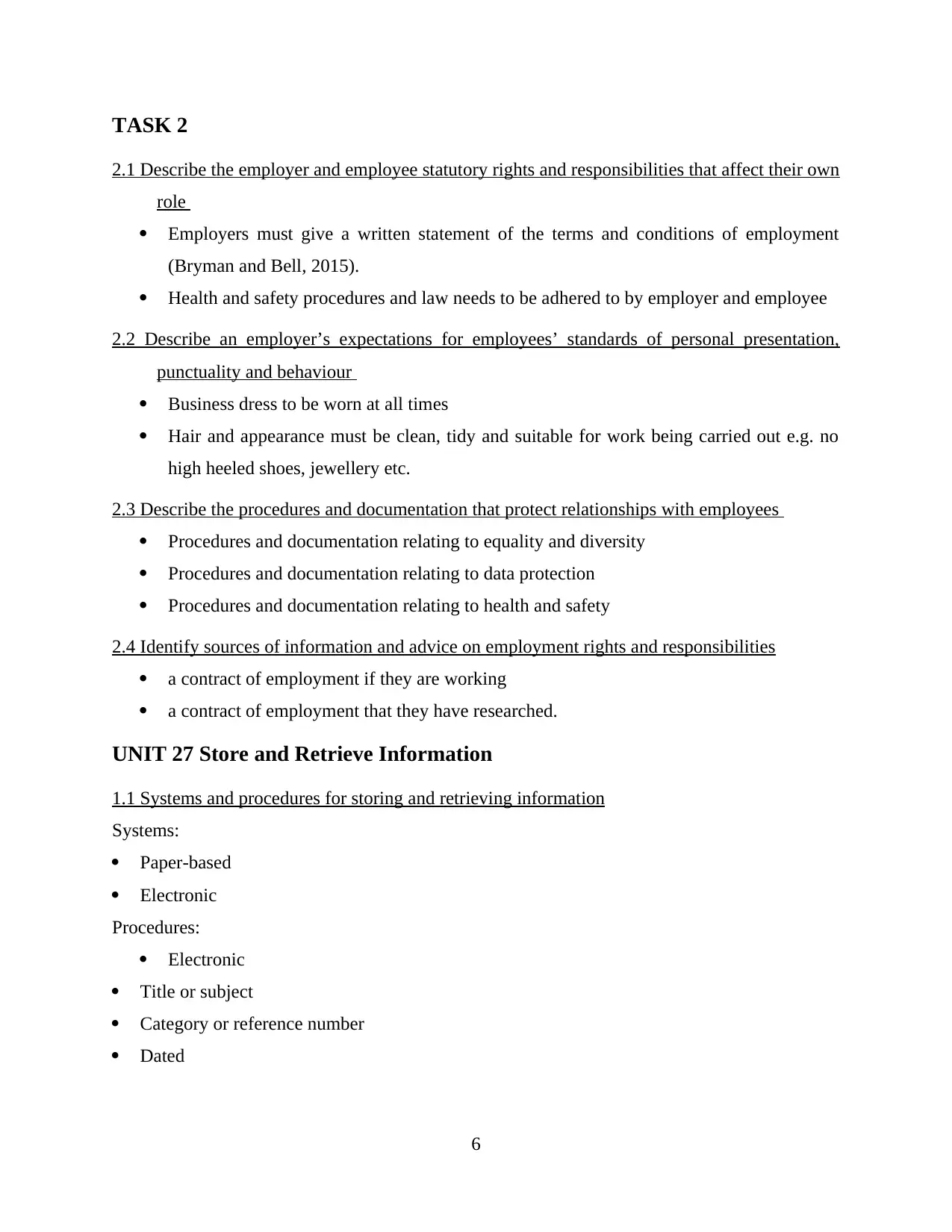
TASK 2
2.1 Describe the employer and employee statutory rights and responsibilities that affect their own
role
Employers must give a written statement of the terms and conditions of employment
(Bryman and Bell, 2015).
Health and safety procedures and law needs to be adhered to by employer and employee
2.2 Describe an employer’s expectations for employees’ standards of personal presentation,
punctuality and behaviour
Business dress to be worn at all times
Hair and appearance must be clean, tidy and suitable for work being carried out e.g. no
high heeled shoes, jewellery etc.
2.3 Describe the procedures and documentation that protect relationships with employees
Procedures and documentation relating to equality and diversity
Procedures and documentation relating to data protection
Procedures and documentation relating to health and safety
2.4 Identify sources of information and advice on employment rights and responsibilities
a contract of employment if they are working
a contract of employment that they have researched.
UNIT 27 Store and Retrieve Information
1.1 Systems and procedures for storing and retrieving information
Systems:
Paper-based
Electronic
Procedures:
Electronic
Title or subject
Category or reference number
Dated
6
2.1 Describe the employer and employee statutory rights and responsibilities that affect their own
role
Employers must give a written statement of the terms and conditions of employment
(Bryman and Bell, 2015).
Health and safety procedures and law needs to be adhered to by employer and employee
2.2 Describe an employer’s expectations for employees’ standards of personal presentation,
punctuality and behaviour
Business dress to be worn at all times
Hair and appearance must be clean, tidy and suitable for work being carried out e.g. no
high heeled shoes, jewellery etc.
2.3 Describe the procedures and documentation that protect relationships with employees
Procedures and documentation relating to equality and diversity
Procedures and documentation relating to data protection
Procedures and documentation relating to health and safety
2.4 Identify sources of information and advice on employment rights and responsibilities
a contract of employment if they are working
a contract of employment that they have researched.
UNIT 27 Store and Retrieve Information
1.1 Systems and procedures for storing and retrieving information
Systems:
Paper-based
Electronic
Procedures:
Electronic
Title or subject
Category or reference number
Dated
6
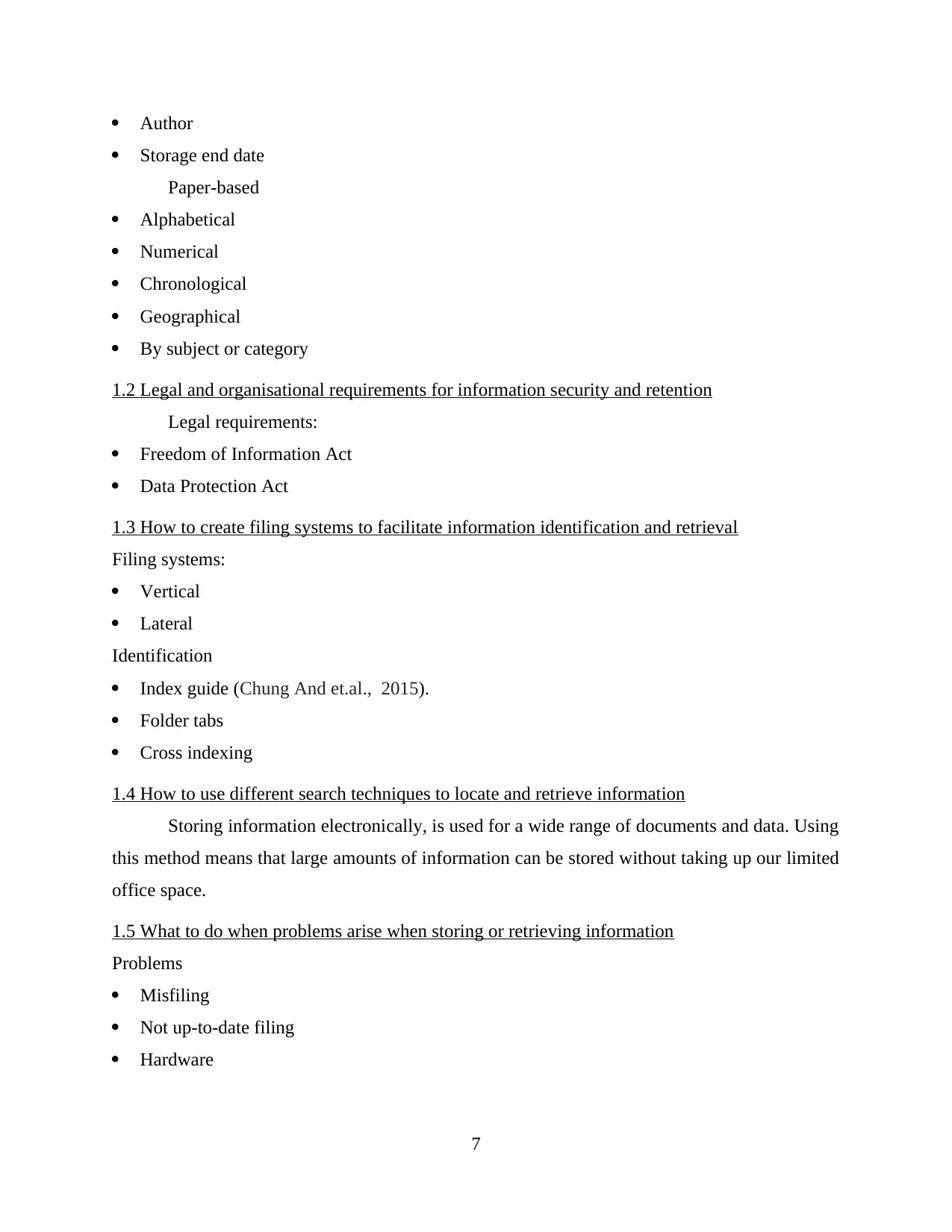
Author
Storage end date
Paper-based
Alphabetical
Numerical
Chronological
Geographical
By subject or category
1.2 Legal and organisational requirements for information security and retention
Legal requirements:
Freedom of Information Act
Data Protection Act
1.3 How to create filing systems to facilitate information identification and retrieval
Filing systems:
Vertical
Lateral
Identification
Index guide (Chung And et.al., 2015).
Folder tabs
Cross indexing
1.4 How to use different search techniques to locate and retrieve information
Storing information electronically, is used for a wide range of documents and data. Using
this method means that large amounts of information can be stored without taking up our limited
office space.
1.5 What to do when problems arise when storing or retrieving information
Problems
Misfiling
Not up-to-date filing
Hardware
7
Storage end date
Paper-based
Alphabetical
Numerical
Chronological
Geographical
By subject or category
1.2 Legal and organisational requirements for information security and retention
Legal requirements:
Freedom of Information Act
Data Protection Act
1.3 How to create filing systems to facilitate information identification and retrieval
Filing systems:
Vertical
Lateral
Identification
Index guide (Chung And et.al., 2015).
Folder tabs
Cross indexing
1.4 How to use different search techniques to locate and retrieve information
Storing information electronically, is used for a wide range of documents and data. Using
this method means that large amounts of information can be stored without taking up our limited
office space.
1.5 What to do when problems arise when storing or retrieving information
Problems
Misfiling
Not up-to-date filing
Hardware
7
⊘ This is a preview!⊘
Do you want full access?
Subscribe today to unlock all pages.

Trusted by 1+ million students worldwide
1 out of 23
Related Documents
Your All-in-One AI-Powered Toolkit for Academic Success.
+13062052269
info@desklib.com
Available 24*7 on WhatsApp / Email
![[object Object]](/_next/static/media/star-bottom.7253800d.svg)
Unlock your academic potential
Copyright © 2020–2025 A2Z Services. All Rights Reserved. Developed and managed by ZUCOL.





